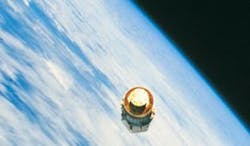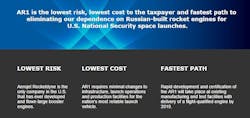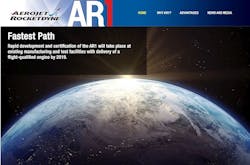Aerojet Rocketdyne advances liquid rocket engines, sets standard for 3D-printed propulsion
SACRAMENTO, Calif., 6 Jan. 2016. Aerojet Rocketdyne, a subsidiary of Aerojet Rocketdyne Holdings Inc. (NYSE:AJRD), won a $6 million U.S. Air Force contract to define standards for qualifying additively manufactured components for use in liquid-fueled rocket engine applications. The company is one of five aerospace technology providers to win awards based on the U.S. Air Force’s Booster Propulsion Technology Maturation Broad Agency Announcement (BAA).
Air Force officials are anxious to transition away from the Russian-made RD-180 engines currently used on the Atlas V launch vehicle from United Launch Alliance (ULA) in Centennial, Colo. Under the new contract, Aerojet Rocketdyne engineers will work to establish the standards to qualify 3D-printed rocket engine components for flight.
“New liquid rocket engine designs—like the AR1 engine we are building to replace the Russian-made RD-180—are increasingly taking advantage of 3D printing technology because it reduces the amount of time and money required to build these complex components,” said Julie Van Kleeck, vice president of Advanced Space & Launch Programs at Aerojet Rocketdyne. “It is imperative that engine manufacturers understand the qualification methodology for this revolutionary technology because of the criticality of the assets they help launch into space.”
The use of additive manufacturing technology reduces the cost to produce components, shortens build times, and provides flexibility to engineers to design components that were once impossible to build using traditional manufacturing techniques, officials explain. This program will define the rigorous engineering and inspection processes to be followed when producing and testing 3D-printed components to assure that they meet the stringent requirements of aerospace systems.
Aerojet Rocketdyne has a history of developing new materials and manufacturing processes that support complex engine designs. Last year, the company successfully hot-fire tested an engine made entirely with additive manufacturing that had a thrust of 5,000 pounds, and earlier this year the company used additive manufacturing to replicate the injector of the gas generator used on the Apollo-era F-1 rocket engine to demonstrate that a proven design can be built at a competitive cost without sacrificing performance.
“We are taking our seven decades of experience in building rocket engines, which represents more than 2,100 successful launches, and combining that with our in-depth knowledge of additive manufacturing to assist the Air Force in defining qualification requirements for this technology,” said Dr. Jay Littles, director of Advanced Launch Vehicle Propulsion at Aerojet Rocketdyne. “In fact, Fast Company magazine named Aerojet Rocketdyne No. 1 in its ranking of ‘The World’s Top 10 Most Innovative Companies of 2015 in Space,’ because of the company’s advances in additive manufacturing.”
“Incorporating additive manufacturing and the new qualification processes into our AR1 design will be essential to having an American engine for the Atlas V and proposed Vulcan launch vehicles ready by 2019,” added Van Kleeck.
Aerojet Rocketdyne provides propulsion and energetics to the space, missile defense and strategic systems, tactical systems, and armaments areas, in support of domestic and international markets.
Images courtesy Aerojet Rocketdyne.
Related information:
You might also like:
Subscribe today to receive all the latest aerospace technology and engineering news, delivered directly to your e-mail inbox twice a week (Tuesdays and Thursdays). Sign upfor your free subscription to the Intelligent Inbox e-newsletter at http://www.intelligent-aerospace.com/subscribe.html.
Connect with Intelligent Aerospace on social media: Twitter (@IntelligentAero), LinkedIn,Google+, and Instagram.



